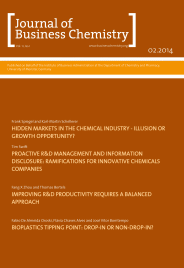Journal of Business Chemistry February 2014
The chemical industry is facing various challenges that derive from global trends such as demographic changes, increasing globalization and urbanization, emerging technologies, or energy and resource scarcity. In order to appropriately respond to such changes in the firm’s environment, firms may be forced to exploit and reinforce existing capabilities as well as explore new opportunities […]
1 Introduction The chemical-pharmaceutical industry in Germany plays an important role. With its many different products, the industry stands at the beginning of a long supply chain. Over the last number of decades, the high innovation rate has contributed to high growth rates in Germany, even though the market was saturated. The chemical industry in […]
A common view is that investors view steady firm-level R&D investment as evidence of the firm’s commitment to R&D-based innovation. However, recent research shows that R&D expenditure volatility is positively related to firm performance, suggesting that higher levels of R&D expenditure volatility indicate effective governance of the R&D function. This paper shows that the relationship […]
In recent years pharmaceutical companies have implemented Operational Excellence (OpEx) in their R&D organizations to improve productivity but had only limited success. Practitioners and management start to question the effectiveness of process- focused improvement methodologies. In this article, we illustrate a number of challenges OpEx practitioners face and argue that our long-held assumptions and lack […]
The forecasted bioplastic production capacity has signaled a strong growth in the next years, but with higher participation of drop-ins. Drop-in bioplastics are nonbiodegradable materials, identical to their fossil counterparts although obtained from renewable raw materials. The present paper examines why drop-ins have presented growth rates higher than non-drop-ins, analyzing some critical factors of their […]
